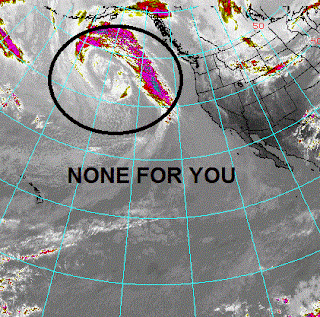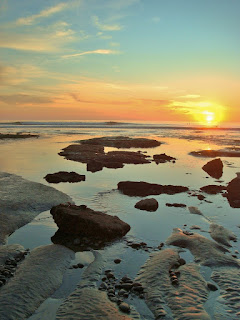Goodbye and good riddance El Nino (if that even is your real name)...
SURF:
Now that the rain is behind us (or lack thereof) and the big surf has subsided, it's been downright pleasant around here.
Today we had a combo NW/SW for chest high surf. The only damper is the on again/off again fog. Once it burned off, you could find a few fun waves up and down the coast. Tomorrow morning holds then late Friday/early Saturday looks small but still rideable.
By Saturday evening we have a new fun NW showing up for shoulder high sets in SD. We'll also have some smaller background SW swell for the OC. Both those hold into Sunday.
Water temps are also holding in the low 60's and tides this weekend are 5' at sunrise (due to Daylight Saving- about 7 AM), down to -1' after lunch, and up to 4' at sunset (due to Daylight Saving- about 7 PM).
FORECAST:
Still have a couple storms floating around the north Pacific that will send us waves- but no real weather.
New NW will fill in Monday afternoon for shoulder high waves. Then some windy/cloudy conditions on Tuesday will give us a short interval overhead NW. After that the it's looking pretty small the 2nd half of next week. The southern hemisphere is coming to life though as we move towards spring and the models are showing a couple storms flaring up.
First is a storm straight S of us that should give us shoulder high sets around the 28th of March.
On it's heels is a similar sized storm that should build next week and shoot us more straight S swell around the 2nd of April. Is the north Pacific shutting down for the season?
WEATHER:
With El Nino (un)officially gone, we've got great weather on tap this weekend as high pressure is in control. The only fly in the ointment is the night/morning low clouds/fog. A storm N of us early next week will swing a cold front our way late Monday into Tuesday. Look for clouds, breezy conditions, and a stray shower or two. El Nino came in a like a lamb and went out like a... lamb. The 2nd half of next week is shaping up to be beach weather with sunny skies and temps in the mid-70's. Make sure to keep up to date on the conditions at
Twitter/North County Surf.
BEST BET:
Sunday is the call: Peaking NW swell and nice conditions.
NEWS OF THE WEEK:
Wasn’t that an utter disappointment. Remember in 2014 all the talk (including yours truly) about a strong El Nino? It had a couple hiccups (see my explanation
here) and we waited instead for the 'Godzilla El Nino' to arrive this winter. Well, we’re below average on rainfall and spring starts in just 4 days. So what the hell happened (again)?! I want answers dagnabit! Heads are going to roll! The National Oceanic and Atmospheric Administration says El Nino lived up to the hype (i.e. everyone else was on track except for us):
The strong El Niño of 2015/16 is now on the decline, and the CPC/IRI forecast says it’s likely that conditions will transition to neutral by early summer, with about a 50% chance of La Niña by the fall. In this post, we’ll take a look back at this past winter and forward to what may happen next.
Current events:
El Niño has begun to weaken, with sea surface temperature anomalies across most of the equatorial Pacific decreasing over the past month. The large amount of warmer-than-average waters below the surface of the tropical Pacific (the “heat content”) also decreased sharply, despite getting a small boost in January. The heat content is the lowest it’s been in over a year, and since the subsurface heat feeds El Niño’s warm surface waters, this is another sign that the event is tapering off.
That said, there’s still a lot of extra heat in the tropical Pacific, and we expect El Niño’s impacts to continue around the world through the next few months. So far this winter, global rain and snow patterns have mostly been consistent with the expected patterns of El Niño, with some exceptions (that would be us here in sunny So-Cal).
In South America, southern Uruguay, Paraguay, and southern Brazil have received much more rain than their long-term December–February average, and the northern portion of the continent has been dry, as usually occurs this time of year during El Niño. Also consistent (so far) with El Niño’s typical impacts have been Africa’s rainfall patterns (wet in portions of Kenya and Tanzania and dry in southeastern Africa and southern Madagascar), the dryness through Indonesia and northern Australia, and the rains in southeastern China.
The precipitation impacts in North America haven’t been quite as consistent with expectations so far (no s#!+ Sherlock), although the southeast and particularly Florida have received a lot more rain than average. Over the December–February season, the western coast of North America showed a pattern of drier north/wetter south, but the line between the two is shifted somewhat north of where it was during earlier El Niño events. (Years ago you probably read that global warming would shift climate patterns- most likely the heat/desert below us into our region and hence the relatively warmer climates of the Pacific Northwest into the Arctic Circle. Could that be the cause)?

El Niño’s effect on regional temperature is a little less distinct than its effect on precipitation patterns. Since El Niño changes the circulation of the atmosphere all around the world, it essentially changes where we expect rain to fall by steering storms to different locations. Temperature operates differently, especially since global warming is changing the averages. Some of the factors going into the super warm November and December in eastern North America was a good example of how attribution of seasonal temperature patterns is a complicated matter.
Looking forward:
Where does the 50% chance of La Niña come from? Forecasters take into consideration what happened in the past, the predictions of computer models, and current conditions when making their forecast.
La Niña conditions have followed six of the ten moderate and strong El Niños since 1950, including two of the three previous strongest El Niños. However, this small number of cases means that it’s hard to make a very confident forecast based only on the previous events.
Next fall is still many months away, and computer climate models have a difficult time making accurate forecasts through the “spring barrier” period of March–May, which is the time of year when El Niño and La Niña are often weakening and changing into neutral. It’s harder to predict a change in conditions. Nevertheless, most computer models are in agreement that La Niña (strength TBD) will develop by the fall. (What does that mean for our rainfall chances? At this point in time you can say we’ll be below average in rainfall as based on previous La Ninas. But since this El Nino underperformed- maybe La Nina will buck the trend and we’ll get above average rainfall? One can only hope).
There are two models in this graph that are showing a return of El Niño (these models also believe in unicorns, Leprechauns, and a Trump presidency). When a computer model forecast is made, you first have to tell the model what the current conditions are (“initializing” the model). For example, you tell it the current sea surface temperature, so it knows where to start.
The way we get a variety of possible outcomes is to start the models with slightly different initial conditions; the differences grow over time. Modelers can use different observation data sets, or use a few different recent days from a single data set, or use one set of observations and add in the range of uncertainty.
The two models that show a return to El Niño happen to use the exact same data set for the initial conditions. The prediction models are different, so they react to the initial data differently, which leads to different outcomes. However, this particular data set used for the initial conditions has unrealistically cold temperatures in the tropical Atlantic Ocean. This smells fishy so it is currently being investigated. The fact these two models are both predicting El Niño next winter could be related to this issue.

To ENSO researchers, this is pretty interesting, because the relationship between the Atlantic and the Pacific isn’t very clear. But right now, it means we aren’t placing a lot of weight on those forecasts for El Niño next year. The next few months should give us a clearer picture. (Long story short- are we in a historically dry period so no matter what El Nino does- we’re screwed? Or is it impossible to predict the weather and we could actually get average or above average rainfall next winter? At this point in time, the El Nino forecast of 2014 AND 2015 were wrong, so a dry La Nina of 2016 will probably be wrong too)!
PIC OF THE WEEK:
If you live on the east coast, you can pretend this is a peak all to yourself during a dawn patrol session. Or if you're a west coaster like me, this would be at sunset and a good way to end the day. But what if you lived in a spot that was north or south facing- you'd never see this! Or would you? I'm confused. Maybe I'm overthinking it.
Keep Surfing,
Michael W. Glenn
Eye of the Tiger
Son of a Son of a Leprechaun
Switched My Tuxedo Vest for an Inflatable One At My Wedding


















































